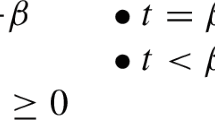Abstract
In the paper, the question whether truth values can be assigned to the propositions before their verification is discussed. To answer this question, a notion of a propositionally noncontextual theory is introduced that to explain the verification outcomes provides a map linking each element of a complete lattice identified with a proposition to a truth value. The paper demonstrates that no model obeying such a theory and at the same time the principle of bivalence can be consistent with the occurrence of a non-vanishing “two-path” quantum interference term and the quantum collapse postulate.
Similar content being viewed by others
Notes
For an approach to unsharp (and partial) forms of a quantum logic, see [6].
This definition is motivated by a similar one introduced in the paper [7].
This approach to the generalization of the notion of a probability function allows to accommodate variation in the background logic of the account while maintaining the core of standard probability theory [9].
The wording “the second-order interference term” is from [10].
One can easily notice that the description of a double-slit interference experiment presented above bears a great deal of similarity to Einstein’s example of a particle confined to a two-chambered box. See the detailed analysis of this example in [17].
References
Kochen, S., Specker, E.: The problem of hidden variables in quantum mechanics. J. Math. Mech. (now Indiana University Mathematics Journal) 17(1), 59–87 (1967)
Liang, Y-Ch., Spekkens, R., Wisemand, H.: Specker’s parable of the overprotective seer: a road to contextuality, nonlocality and complementarity. Phys. Rep. 506, 1–39 (2011)
Dzhafarov, E., Kujala, J., Cervantes, V.: Contextuality-by-default: a brief overview of ideas, concepts, and terminology. In: Atmanspacher, H., Filk, T., Pothos, E. (eds.) Lecture Notes in Computer Science, vol. 9535, pp. 12–23. Springer, Berlin (2016)
Simmons, A., Wallman, J., Pashayan, H., Bartlett, S., Rudolph, T.: Contextuality under weak assumptions. arXiv:1610.06897 (2016)
Harrigan, N., Rudolph, T.: Ontological models and the interpretation of contextuality. arXiv:0709.4266 (2007)
Chiara, D., Giuntini, R.: Partial and unsharp quantum logics. Found. Phys. 24(8), 1161–1177 (1994)
Arora, A., Arvind.: A non-contextual hidden variable model for quantum mechanics. arXiv:1607.03498 (2016)
Pykacz, J., Fra̧ckiewicz, P.: The Problem of Conjunction and Disjunction in Quantum Logics. Int. J. Theor. Phys. doi:10.1007/s10773-017-3402-y (2017)
Weatherson, B.: From Classical to Intuitionistic Probability. Notre Dame J. Form. Log. 44(2), 111–123 (2003)
Sinha, U., Couteau, C., Medendorp, Z., Söllner, I., Laflamme, R., Sorkin, R., Weihs, G.: Testing Born’s rule in quantum mechanics with a triple slit experiment. arXiv:0811.2068 (2008)
Pykacz, J.: Fuzzy quantum logics and infinite-valued Łukasiewicz logic. Int. J. Theor. Phys. 33, 1403–1416 (1994)
Pykacz, J.: Quantum logic as partial infinite-valued Łukasiewicz logic. Int. J. Theor. Phys. 34(8), 1697–1710 (1995)
Pykacz, J.: Łukasiewicz operations in fuzzy set and many-valued representations of quantum logics. Found. Phys. 30, 1503–1524 (2000)
Pykacz, J.: Unification of two approaches to quantum logic: every Birkhoff–von Neumann quantum logic is a partial infinite-valued Łukasiewicz logic. Stud. Logica 95, 5–20 (2010)
Pykacz, J.: Towards many-valued/fuzzy interpretation of quantum mechanics. Int. J. Gen. Syst. 40, 11–21 (2011)
Pykacz, J.: Can many-valued logic help to comprehend quantum phenomena? Int. J. Theor. Phys. 54, 4367–4375 (2015)
Norton, J.: Little boxes: a simple implementation of the Greenberger, Horne, and Zeilinger result for spatial degrees of freedom. Am. J. Phys. 79(2), 182–188 (2011)
Acknowledgements
The author would like to thank the anonymous referee for the inspiring feedback and the insights.
Author information
Authors and Affiliations
Corresponding author
Rights and permissions
About this article
Cite this article
Bolotin, A. Contextuality and truth-value assignment. Quantum Stud.: Math. Found. 5, 351–355 (2018). https://doi.org/10.1007/s40509-017-0141-y
Received:
Accepted:
Published:
Issue Date:
DOI: https://doi.org/10.1007/s40509-017-0141-y



